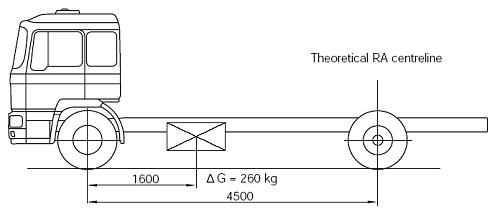Related Resources: power transmission
Truck and Car Axle Load Equations
Power Transmission Design and Engineering
Engineering and Design Applications
Truck and Car Axle Load Equations.
To optimize the vehicle and achieve the correct superstructure ratings, an axle load calculation is essential. The body can be matched properly to the truck only if the vehicle is weighed before any body building work is carried out. The weights obtained in the weighing process are to be included in the axle load calculation.
The following section will explain an axle load calculation. The moment theorem is used to distribute the weight of the equipment to the front and rear axles. All distances are with respect to the theoretical front axle centerline. For ease of understanding, weight is not used in the sense of weight force (in N) in the following formulae but in the sense of mass (in kg).
Rear axle weight difference
ΔGH = ( ΔG · a ) / It
Front axle weight difference
ΔGv = ΔG - ΔGH
Example:

Example:
A 400 liter tank is to be installed instead of a 140 liter tank. A calculation of the weight distribution between the front and rear axles is required.
Difference in weight ∆G = 400 – 140 = 260 kg
Distance from theoretical front axle centerline = 1600 mm
Theoretical wheelbase It = 4500 mm
Solution Rear Axle:
ΔGH = ( ΔG · a ) / It
ΔGH = ( 260 kg · 1600 mm ) / 4500 mm
ΔGH = 92 kg
Solution Front Axle:
ΔGv = ΔG - ΔGH
ΔGv = 260 kb - 92 kg
ΔGv = 168 kg
- Dimensions
- all distances/clearances that are IN FRONT OF the theoretical front axle centerline have a MINUS sign (-)
- all distances that are BEHIND the theoretical front axle centerline have a PLUS sign (+)
- Weights
- all weights that are ADDED TO the vehicle have a PLUS sign (+)
- all equipment weights that are REMOVED FROM the vehicle have a MINUS sign (-)
Example 2
Attaching a snowplow plate
Weight ∆G = 120 kg
Distance from first axle centerline a = -1600 mm
Theoretical wheelbase lt = 4500 mm
A calculation of the weight distribution to the front and rear axle is required.
Rear axle
ΔGH = ( ΔG · a ) / It
ΔGH = ( 120 kg · ( -1600 mm ) )/ 4500 mm
ΔGH = -43 kg
Front axle:
ΔGV = ∆G - ∆GH = 120 - (-43)
ΔGV = 163 kg, the weight on the front axle is increased.
The following table shows an example of a full axle load calculation. In this example, two variants are compared (variant 2 has stronger front springs and larger tyres on the front axle.
Open Example: Full Load Calculations